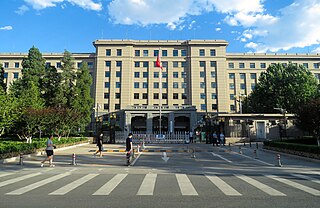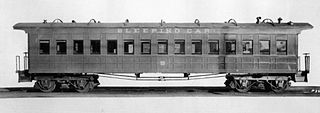
The sleeping car or sleeper is a railway passenger car that can accommodate all its passengers in beds of one kind or another, primarily for the purpose of making nighttime travel more restful. George Pullman was the American inventor of the sleeper car.

First class is the most luxurious travel class of seats and service on a train, passenger ship, airplane, bus, or other system of transport. It is usually more expensive than business class and economy class, and offers the best service and luxurious accommodation.

Indian Railways (IR) is India's national railway system operated by the Ministry of Railways. It manages the fourth largest railway network in the world by size, with 67,368-kilometre (41,861 mi) route.. Routes are electrified with 25 KV AC electric traction while thirty three percent of them are double or multi-tracked.
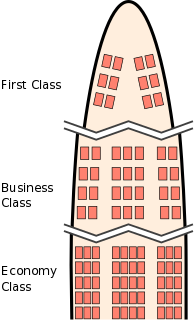
A travel class is a quality of accommodation on public transport. The accommodation could be a seat or a cabin for example. Higher travel classes are designed to be more comfortable and are typically more expensive.
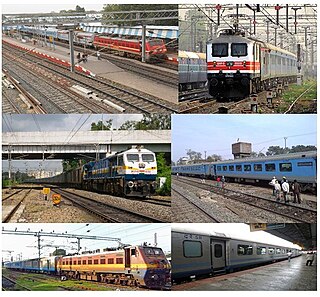
Shatabdi Express trains are a series of fast passenger trains operated by Indian Railways to connect Metro cities with other cities important for tourism, pilgrimage or business. Shatabdi Express are day-trains and they return to the station of origin the same day.
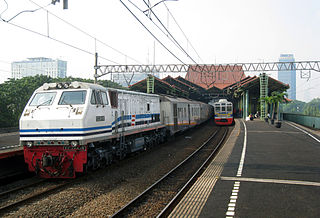
The majority of Indonesia's railways are on Java, used for both passenger and freight transport. There are three noncontinuous railway networks in Sumatra with two new networks is being developed in Kalimantan and Sulawesi. Indonesia has finalized its plan for a national railway network recently. According to the plan, 3,200 km of train tracks that will criss-cross the islands of Sumatra, Java, Kalimantan, and Sulawesi, it has been touted as the most extensive railway project in Indonesia since its independence from the Dutch in 1945.

The Beijing–Shanghai high-speed railway is a high-speed railway 1,318 kilometres (819 mi) long that connects two major economic zones in the People's Republic of China: the Bohai Economic Rim and the Yangtze River Delta. Construction began on April 18, 2008, with the line opened to the public for commercial service on June 30, 2011. It is the world's longest high-speed line ever constructed in a single phase. The line is one of the busiest high speed railways in the world, transporting over 180 million annual passengers in 2017, more than the annual ridership of the entire TGV or Intercity-Express network. It is also China's most profitable high speed rail line, reporting a 6.6 billion yuan net operational profit in 2015.

Passenger rail transport is one of the principal means of transport in the People's Republic of China, with rail passenger traffic exceeding 1.86 billion railway trips in 2011. It is operated by the China Railway Corporation(CR). The Spring Festival Travel Season is the peak railway travel season of the year.
City Night Line, abbreviated CNL, was a train category of German railway company Deutsche Bahn for overnight passenger train services between Germany and neighbouring European countries. In late 2015, Deutsche Bahn announced that it planned to terminate all night train services in December 2016, and this plan was implemented on 11 December 2016. The service on some CNL routes was replaced by ÖBB Nightjet services.

The CRH2 Hexie is one of the high-speed train models in China. Originally, the CRH2 was based on the E2-1000 Series Shinkansen design from Japan with the license purchased from a consortium formed of Kawasaki Heavy Industries, Mitsubishi Electric Corporation, and Hitachi, and represents the second Shinkansen train model to be exported.

Andhra Pradesh State Road Transport Corporation is the state-owned road transport corporation in the Indian state of Andhra Pradesh. Its headquarters is located at NTR Administrative Block of RTC House in Pandit Nehru bus station of Vijayawada. Many other Indian metro towns in Telangana, Tamil Nadu, Karnataka, Odisha, Yanam and Chhattisgarh are also linked with the services...
China Railway High-speed (CRH) is a high-speed rail service operated by China Railway.

The CRH1 EMU, also known as Hexie is a high-speed train operated by China Railway and built by a joint venture between Bombardier Transportation and Sifang at Bombardier Sifang Power Transportation factory in Qingdao, Shandong Province, People's Republic of China.

The Garib Rath is a no-frills air-conditioned train started by the Indian Railways in 2005 to provide subsidized price air-conditioned long-distance travel to passengers who could not afford standard fares of air-conditioned class in regular-fare trains. As the fares are less than two-thirds of the fares for air-conditioned classes in other trains, the distance between each seat or berth is less, the seats and berths are narrower and each coach has more seats and berths than in air-conditioned coaches in other trains.
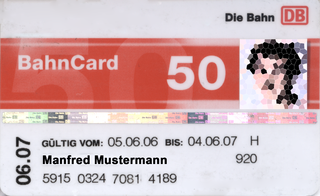
BahnCard is a discount subscription programme offered by Deutsche Bahn (DB), the German national railway company. Unlike airline loyalty programs, but similarly to the UK Railcard, the BahnCard entitles the passenger to a discount price and must be purchased prior to travel. BahnCard contracts are automatically renewed each year, unless they are cancelled with sufficient notice. Three variants of BahnCard are sold by Deutsche Bahn: The BahnCard 25, the BahnCard 50, and the Mobility BahnCard 100. The first two variants allow passengers to get 25% and 50% discount respectively on standard long distance rail fares, while the Mobility BahnCard 100 is a type of annual ticket that allows free unlimited travel on most of the German railway network for a fixed price.
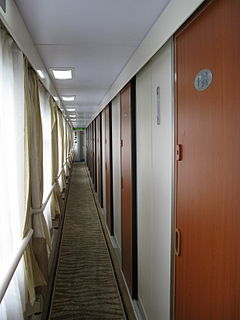
The Soft Sleeper, abbreviated RW or WR (CRH), is a passenger railway compartment class in the People's Republic of China. Soft sleeper is the main class on most Z-series express trains, and are grouped in several carriages as part of slower trains. They are more expensive than hard sleepers but are generally more comfortable as there is more room to move around and the bunks tend to be, albeit not always, softer in firmness. In many soft sleeper compartments, there is entertainment available through headphones connected to an LCD screen, although this is by no means universal.

The Wuhan–Guangzhou high-speed railway, also called the Wuguang high-speed railway and short for Beijing–Guangzhou–Shenzhen–Hong Kong high-speed railway, Wuhan–Guangzhou section, is a 968-kilometre (601 mi) high-speed rail line, operated by China Railway High-speed (CRH), connecting Wuhan and Guangzhou, the provincial capitals of Hubei and Guangdong, respectively. It was the world's fastest train service, initially using coupled CRH2C and CRH3C trains which averages 313 km/h (194 mph) in non-stop commercial service.
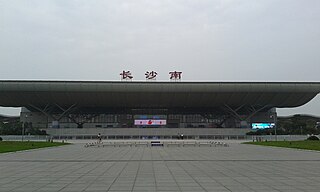
Changsha South railway station is a metro station and a railway station of Wuguang Passenger Railway and Hukun Passenger Railway. The station is located in Yuhua District, Changsha, Hunan, China. It is a hub and the connecting point of Beijing–Guangzhou–Shenzhen–Hong Kong High-Speed Railway, Shanghai–Kunming High-Speed Railway and the proposed Xiamen-Changsha-Chongqing High-Speed Railway. The station, located in Lituo Street, Yuhua District, was opened Dec 26, 2009. The designer of the station building is from the 3rd department of Central South Architectural Design Institute, INC. The roof features the waves and ripples of water. It has a total construction area of 273,000 square meters and the depot area is 137,000 square meters. It is a transportation center of high-speed railroads, metro lines 2&4, buses, maglev and coaches, which can seamless connect with the downtown, Huanghua International Airport and cities in the vicinity.

Garib Rath service was introduced in 2005 by former Indian railway minister Lalu Prasad Yadav. It is an air conditioned Superfast express train that can run at the same speed as Rajadhani Express or Shatabdi Express. The specialty of the service is the ticket fare is inexpensive compared to the other luxury trains and it is faster than other express trains.
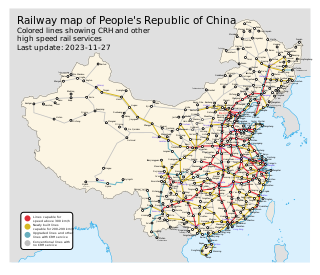
Rail transport is an important mode of long-distance transportation in the People's Republic of China. As of 2015, the country has 121,000 km (75,186 mi) of railways, the second longest network in the world. By the end of 2018, China had 29,000 kilometres of high-speed rail (HSR), the longest HSR network in the world.[4]
